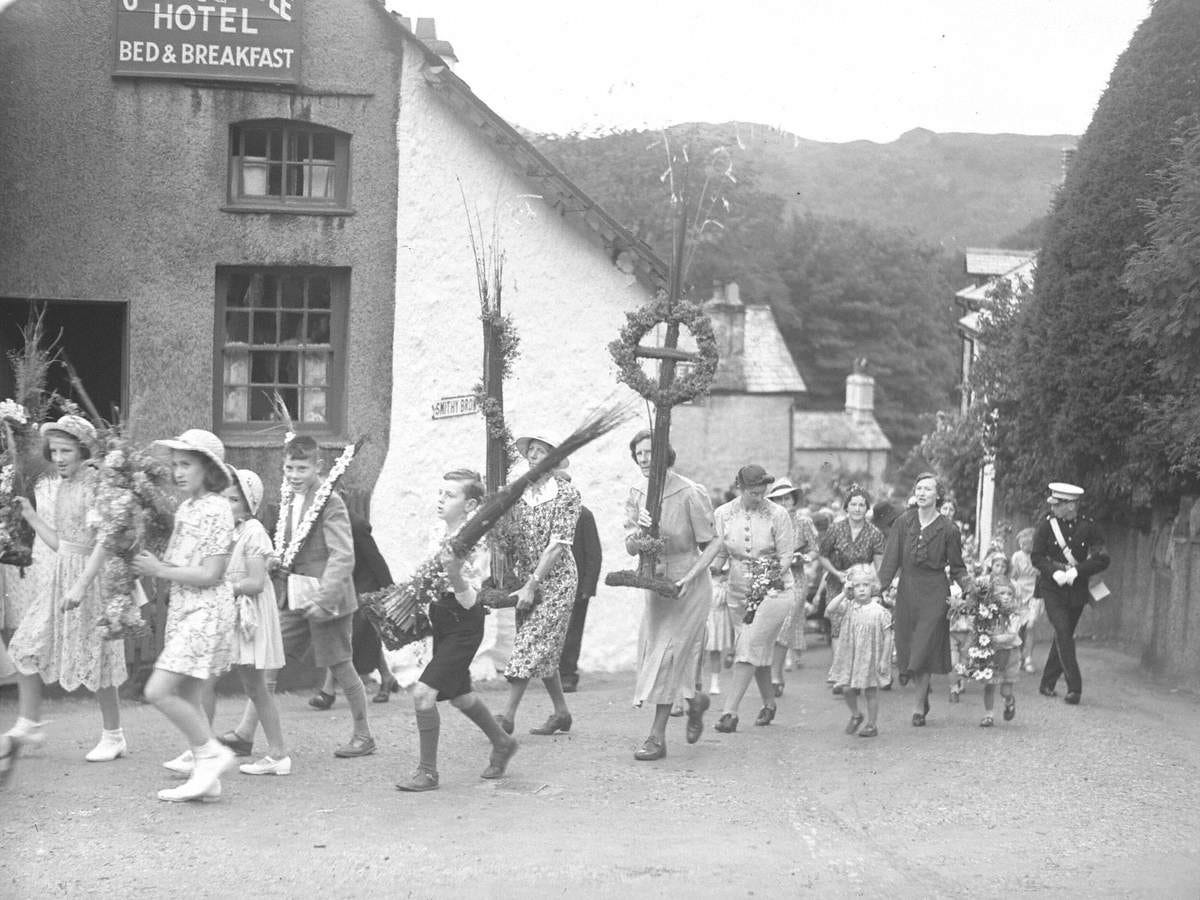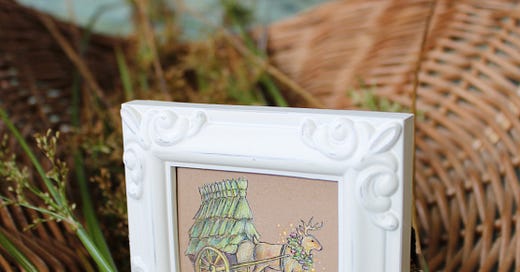To-day we come from farm and fell, / Wild flowers and rushes green we twine
Rushbearing: Historical Overview

To-day we come from farm and fell,
Wild flowers and rushes green we twine;
We sing the hymn we love so well
And worship at St. Oswald’s shrine.Canon Rawnsley, Hymn for the Rushbearing

Are you ready to dive down the (rush-strewn) rabbit-hole?
Though not exhaustive at all, this chat about the history of rushbearing will be a somewhat lengthy one - pour a glass of iced tea, settle in, and let’s imagine ourselves into some ancient, rustic scenes to really get the flavor of this summer festival.
Before flooring became the standard, buildings had long been strewn with rushes for insulation & comfort - with herbs & flowers often mixed in for their pleasant scent and natural pest-repellent traits. Historical sources, though, don’t mention rushbearing as a religious ritual until the 16th century - still, there’s reason to believe that it dates to the Middle Ages. It certainly has that ancient flair about it.
This tradition (both pragmatic and poetic all at once) of periodically bearing fresh rushes to homes, shops, and houses of worship was steadily formalized & adopted by the Church.12 An annual festival was held near the feast day of the parish's patron saint for those churches bearing the name of summertime saints3 - since the summer months were the height of the hay harvest & rush availability. Parishioners would harvest rushes (or purchase them), and bring them to the church in the form of a lovely, flower-bedecked procession. Local farmers brought their freshly-cut rushes or hay to contribute to the festival & the adorning of the church, too.
Churchwardens’ accounts contain a plethora of examples spanning regions and time that show the importance of rushbearing in church life:4
1408 For one trusse of stree - - - vid.
1427 For rushes at Easter - - - vid.
” For straw at Chrystmas - - - ixd.
1599 Payd for rosmarye and bayes ye whole yeare5 1s. vid.
” For a load of green rushes - - - viiid.
1638 Payde the Clarke for strewings at Christmas 1s.All Saints’, Bristol
1630 Paid to Robert Raborne for getting out the old rushes of the church, 00,, 00,, viijd.
Frodsham Town Accounts
1546 For rysshes in festo Pasce - - - iiijd.
“ “ ryngyng at Ester - - - viijd.
“ “ rysshes at Wytsontyd - - - vjd.
“ “ “ “ Mydsomer - - - viijd.
1551 “ rushyes in festo omn’ sanctor’ - - - vjd.
1552 “ russhes against All Hallowtyde - - - xd.
“ “ ryngyng on All Hallow’s nyght - - - xvjd.
1584 To Edward Griffith for boughs, rishes, and other thinges, at what time the Earle of Leicester came hither - - - xviijs. ijd.Treasurer’s Accounts, Chester Cathedral
A festival both liturgical and agricultural, rushbearing had to be as adaptable as the regional farms - the local festival date would be moved for weather or to account for an early/late season for the hay & rushes.
The tenor of the annual rushbearing festival also varied regionally - some rushbearings were more sedate, with delightful , garlanded processions on foot toward the church. Others shifted toward lively festivals, adopting the rush cart: a cart artfully stacked with rushes, pulled by either men or horses, accompanied by Morris dancers, etc.
Rushbearing culminated in a service at the church, where the garlands and floral bearings were hung, followed by tea, gingerbread, & celebration.
Even after flooring was installed in most buildings, rushbearing was so beloved a tradition that it persisted - while the necessity for the rush insulation had passed, the spiritual intent and opportunity for celebration continued. Some rushbearings still occur annually, or have been revived in the past century in an effort to reinvigorate community and local culture.6
Rush Carts & Shedlock Carts

The central figure of the liveliest rushbearings, the rush cart was stacked with bundles of rushes piled in a pyramid shape, topped with oak boughs and often adorned with patriotic or regional symbols. It was pulled by men or by horses, and a rider usually sat atop the cart.
Valuables like silverware, tankards, etc. were sometimes hung from the rushes, tinkling and gleaming in the sun - and also a show of local pride. These rush carts were accompanied by drummers, Morris dancers, tableaux, and more, making for quite the show on their way to the church.


A testament to the widespread community reach, young children often built a “Shedlock Cart” - a smaller version of a rush cart, with bundles of rushes placed on top of a handwagon and decorated with flowers…especially charlock flowers (called “shedlock” in regional Lancashire dialect) and ragwort. Echoing their larger counterparts, these shedlock carts also had a bough stuck in the top, and the children often carried nosegays of roadside flowers like buttercup.
This tiny, whimsical woodland rushbearing scene is inspired by the Sowerby rushcarts - a garlanded deer pulls the rushcart to a woodland chapel. This little one-of-a-kind, hand-drawn folk art Vignette is now listed in my Etsy shop!
Rush-Bearings

“The ‘bearings’ in the procession consist of crosses, wreaths and garlands made of the beautiful flowers that grow in such profusion there. Every design has rushes as a part of its make up. A cross of rushes wreathed in geraniums, a rush basket full of carnations, a rush cross covered with white lilies, a harp strung with reeds and twined with roses, and often a rush cradle with a doll in it called ‘Moses in the bulrushes.’ Shepherd’s crooks, and serpents of moss twined in among the rushes, are frequent, each one following tradition as well as fancy.”
Anonymous contribution to The Library News-Letter, Wilkes-Barre, PA (1902)
A beloved part of the procession, bearings consisted of rushes plaited into intricate emblems & symbols, like storytelling devices - they were marched through the rushbearing, then displayed in the church, some being laid at the foot of the altar & removed the following week, others being held on designated hooks where they would remain until the next year’s rushbearing festival.
The symbols varied, but some were perennial - crosses, of course, and emblems like a harp (referencing King David), cradles (harkening to Moses in the bulrush cradle), etc.
Rush Sheet

A beautiful part of many processions was the rush sheet - the green- & white-clad rush queen & her party carried a hand-woven linen sheet, its corners embroidered, filled with rushes and flowers to bring to the church.
Flora
The species of rush used for rushbearing varied, but Juncus effusus was common (this is also the rush usually gathered for making rush lights); in fact, the Latin term juncare meant “to strew with rushes.”7 Another rushbearing grass frequently mentioned was Acorus calamus (sweet flag). Bulrushes were used, and, of course, hay & grass.
The flowers & herbs gathered to strew with the rushes & decorate the bearings (symbolic emblems borne during the festival) varied from region to region & with seasonality - heather was common, though, as well as roadside flowers like charlock or ragwort. Essentially, parishioners foraged for whatever the roadsides & hedgerows had to offer near the rushbearing date; garden flowers, especially carnations and lilies, were added, too. Rush carts often had an oak bough swaying at the top of their mound of rushes.
“Besides giving the Church a fresh strewing every feast day, it was in olden times customary to deck it with boughs and flowers; and as the flowers used at festivals were originally selected because they happened to be in bloom then, so in time they came to be associated therewith.”
Richard Folkard, Plant Lore, Legends, and Lyrics
Flavors
“After the service the children have tea, the meal always including cakes of gingerbread, and, it may be, if the presiding powers are generous, some gift, like a bright new sixpence for each, is added as well.”
Mary Boazman, “Rushbearing,” printed in The Country Home, Vol. III (1909)
Rushbearing festivals & services - like so many other traditional English celebrations - rewarded the younger crowd with fresh gingerbread. The gingerbread would sometimes be marked with the Church’s emblem (as in the case of St. Oswald’s in Grasmere).
Thank you so much for joining me as I dip my toes into Substack! It’s been a real pleasure getting to connect with so many kindred spirits here. I’ll be back with more thoughts - on embracing the heritage of rushbearing in our modern lives - later on. In the meantime, always feel free to reach out with thoughts, reflections, or questions!
Blessings,
Kristin
Steve Roud, The English Year: “As often happens with church-based events, the annual rush-strewing took on a celebratory aspect, giving a devotional spin to a practical occasion, and bringing the rushes to the church, or 'rush-bearing', became a major festival in which the whole community could join.”
Mary Boazman, “Rushbearing,” printed in The Country Home, Vol. III (1909): “In their wisdom, clergymen and churchwardens turned a matter of necessity into a religious festival, and thus won the interest and co-operation of the laity…”
Rushes were often refreshed on major feast days, like Christmas, Easter, & Whitsun, as well.
Alfred Burton, Rush-Bearing (1891)
According to Alfred Burton’s notes in Rush-Bearing, rosemary & bay were probably purchased to “strew in the church on days of Humiliation and Thanksgiving, when it was the custom to strew churches with herbs and flowers. The Greeks have a custom at the present day of strewing the floors of their churches with sprigs of myrtle, which give a peculiar crispness and freshness to the atmosphere” (Burton 18)
“Many precious rites
And customs of our rural ancestry
Are gone, or stealing from us.”
Wordsworth, The Excursion (1814)
Examples of this usage in England can be found in Gloucestershire Notes and Queries, Vol. I, ed. Rev. Beaver Blacker, M. A. (1881)







Fascinating stuff, Kristin! I love how there was such pageantry around what would have otherwise been a mundane task. I was remembering scenes from the "Tudor Monastery Farm" series in which they gather rushes, plait them into floor mats, & strew herbs in the floor. On YouTube, starts around 1:15 in this video:
https://youtu.be/5EuVCNwHlJ4
I'm so enjoying how organized your site is, Kristin...I'm catching up & ambling through your posts!
Seeing your quote from the Wilkes-Barre Library News-letter I did a little local research...
I found articles shared in our Pennsylvania papers dating as far back as 1857 -- telling about rush-bearing festivals in England. I'll have to do some more digging. I'm wondering if the articles were simply 'human interest' types of things or if they relate in some way to festivals in our local area churches?